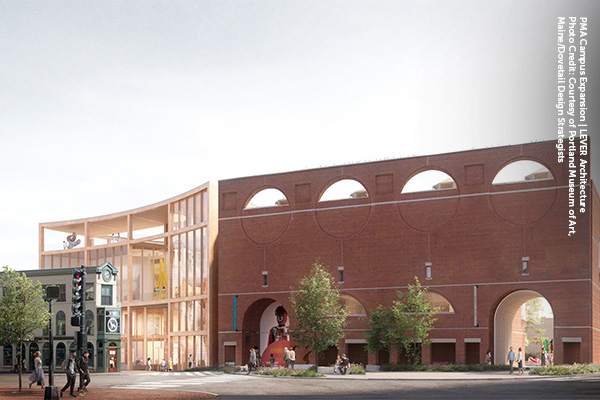HIGHLIGHTS
PROGRAM UPDATES
The AWC Tackles Misinformation on Fire Safety Think Wood Social Campaign Captures Student Interest and Supports Wood Products Education Enhanced WIN Optimizes Light-Frame and Mass Timber Project Discovery SLB Student Engagement Program Teaches Affordable Mass Timber Housing at Texas A&MINDUSTRY RESOUCES
Virginia Tech's Monthly Housing ReportProgram Updates
The AWC Tackles Misinformation on Fire Safety
The AWC’s Fire Service Relations Director Ray O’Brocki was featured as one of two fire safety experts in an in-depth segment for WBTV, a CBS News affiliate, in the wake of the Charlotte, North Carolina, construction fire. The episode reached 2 million viewers locally and is expected to be syndicated to more than 100 other news stations.
“Fire experts like O’Brocki tell WBTV what happened in Charlotte should be a lesson for the entire country,” according to WBTV’s article. “He said the failure to closely follow fire safety codes and regulations is putting workers, firefighters, and entire communities in danger. ‘Nobody thinks they’re going to have a fire,’ O’Brocki said.”
O’Brocki has been engaged with city and state officials since the tragic fire, advising on best practices and precautions that could have prevented the blaze. He has also provided important background information and context to a WBTV television reporter.
O’Brocki’s work with the media complements the AWC’s assertive response to the Charlotte fire, alongside the organization’s involvement in North Carolina fire safety and code revisions following the incident. By combating misinformation, the AWC has helped to reverse the narrative around the fire and defend wood’s market share.
Think Wood Social Campaign Captures Student Interest and Supports Wood Products Education
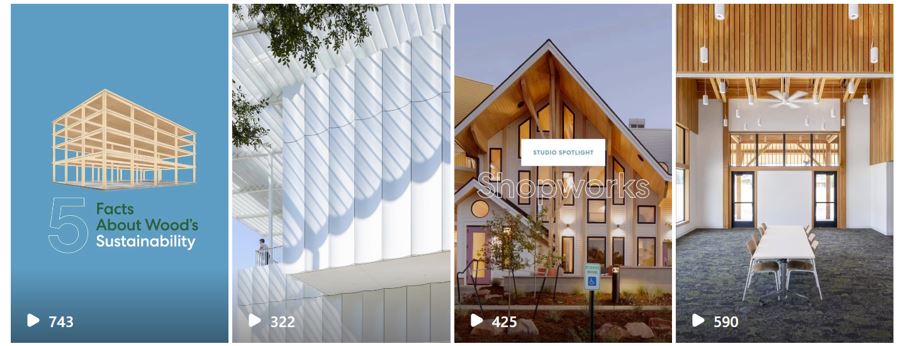
Think Wood is finding success with a social media campaign targeting a new AEC audience: architecture and engineering students. Over three months, engagement has been enthusiastic, with video-based Instagram Reels driving 181 interactions and 4,761 impressions on the platform. The campaign aims to capture designers early in their career path, helping to establish an interest and awareness of wood’s benefits from the onset.
The initiative is a collaboration with SLB Education, which conducted a student survey earlier in the year to learn more about how students seek out information and inspiration on architecture topics. The student audience is a critical one for driving future demand for softwood lumber by generating interest with future architects before they encounter institutional bias for concrete and steel. Students’ enthusiasm for sustainability and building with wood is evident in their social media activity. The survey found that two social channels popular with students at the moment are Instagram Reals short-form video and Pinterest board photo collections.
Think Wood will continue this pilot program into Q4 to learn more about students’ social behavior and to see if these or other social platforms are an effective way to engage with students and plant the seeds for more wood use in their future professional work.
Enhanced WIN Optimizes Light-Frame and Mass Timber Project Discovery
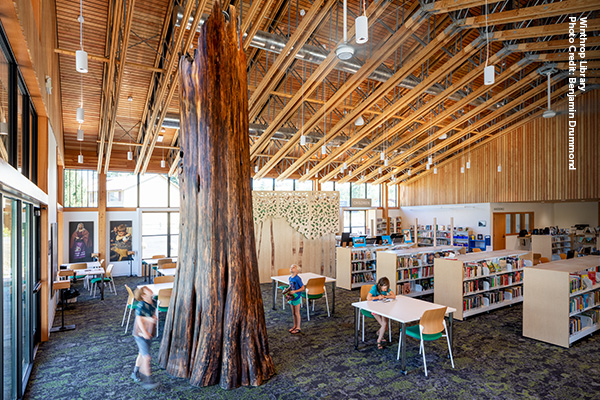
New improvements to the WoodWorks Innovation Network (WIN) website are boosting this well-received industry resource. These enhancements include a new homepage design that reduces multilayer clicking by providing direct access to the information people seek most. The page is topped with a navigation bar with links to the project map, manufacturers and suppliers, and people and companies.
WIN projects are front and center, and visitors have the option of seeing recently added, award-winning, and most-viewed projects at a glance. Visitors can view prefiltered project or member categories directly from the homepage, and modules highlighting member updates offer increased visibility to companies and individuals who are active on the site.
WIN helps drive demand for softwood lumber by making it easier for interested developers and specifiers to connect with professionals who have designed, engineered, and built wood projects, such as the innovative light-frame Winthrop Library (pictured above). Sharing examples of new mass timber buildings reduces the imagined risk for on-the-fence developers. Through WIN, professionals can be inspired by innovative wood buildings and harness the knowledge of the design community to move their own projects forward. Check out the new WIN homepage at WoodWorksInnovationNetwork.org.
SLB Student Engagement Program Teaches Affordable Mass Timber Housing at Texas A&M
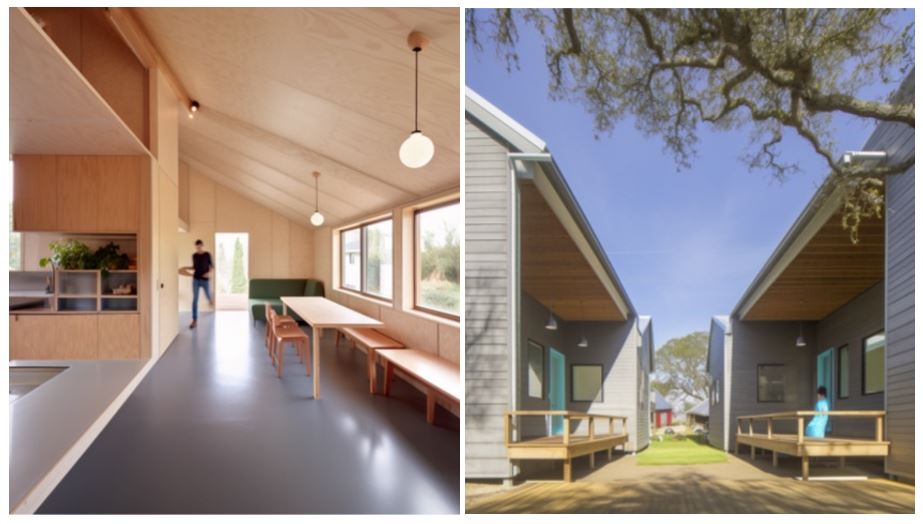
Following an SLB-sponsored field trip this summer, Texas A&M’s School of Architecture students presented final studio designs in which they integrated design theory with mass timber structural systems to develop affordable housing typologies.
The architecture students had visited production facilities at Steely Lumber, Georgia Pacific, and Sterling CLT in East Texas to gain a better understanding of lumber production and sustainable forestry. “After my experiences this summer, I am much more inclined to explore [lumber systems] for future projects, whether they be school- or work-related,” said Mallory Jordan, a fourth-year architecture student in the Texas A&M program.
The comprehensive design studio exposed students to all considerations of a mass timber project, from early site analysis and programming through design detailing and construction document preparation. By supplementing the instruction with real-world lumber production experience, the program helps shape students’ natural enthusiasm for bio-based and sustainable design approaches.
The final design for Team 3 of the architecture studio (pictured above) includes the use of CLT as part of efficient and eco-friendly solutions for affordable housing.
Work by: Aidan Lozano, Andrea Hinojosa, Mallory Jordan, Ian Thomas, Nate Sorensen, Matthew Benedict, Lincoln Clark Bateman, Addison Dunham, Riley Gourley, Alfredo Saenz, Macy Sweat, Madison Wood, Evelyn Esquivel, and Reem Hermas.
Spotlight
Could AI Be a Boon to Sustainable Forestry and Wood Construction?
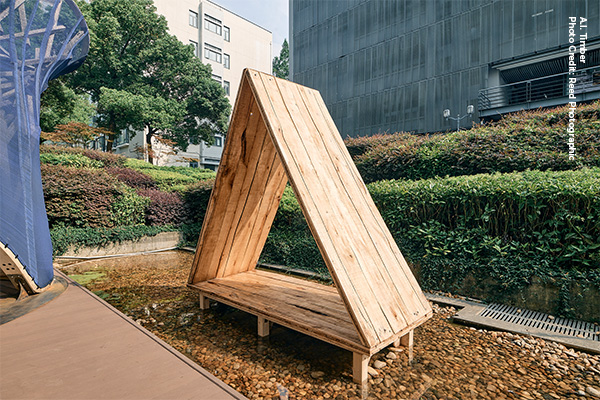
Large, creative AI models will transform lives and labor markets. When it comes to the AEC sector, recent estimates suggested it has the potential to automate up to 37% of the tasks typically carried out by architects and engineers. But much of that will be routine and less creative tasks, allowing designers to focus on the more innovative aspects of their work. From exploring AI generative design options to simply eliminating costly manual processes, industry experts are venturing guesses as to just how broad its impact will be.
Prefabricated wood construction also stands to benefit from AI innovations. The industry is already making inroads through the use of advanced building information modeling (BIM) and computer-numerically controlled (CNC) manufacturing. In fact, AI and machine learning are already being used to improve the optimization of wood in engineered wood products.
A recent startup claims to have launched a method for sustainable cross-laminated timber (CLT) production that uses AI to preserve the original contour of each tree. The company Maestro, founded by Carlo Ratti and Mykola Murashko, attracted global attention with a proof-of-concept design at the DigitalFUTURES conference in Shanghai last month. Dubbed “A.I. Timber,” the firm claims “it will redefine manufactured CLT with an AI-led process.”
According to Ratti, the push to develop A.I. Timber was driven by the need to decarbonize construction, with the U.N. claiming that concrete, steel, and aluminum are responsible for 23% of global emissions. According to Murashko, a 23-year-old Cambridge University graduate, timber unlocks new possibilities for prefabricated construction. “Because engineered wood products are lightweight, renewable, and dimensionally stable, we can design an entire building in our factory and then ship the flatpack of its components to construction sites worldwide,” he said.
AI is also set to disrupt nearly 30% of global forestry, according to a recent Goldman Sachs report. Forest managers are using AI and big data worldwide to monitor biodiversity loss and carbon management. It can analyze satellite imagery to track tree growth and identify areas in need of planting. During timber harvesting, automation and AI can improve efficiency and precision. Waste can be minimized using scanning and modeling of logs. AI could also play a positive role in better wildfire management and better, faster replanting methods.
From the forest to the design studio to the jobsite, professionals throughout the wood construction value chain will be monitoring advancements in AI for opportunities to improve efficiency and sustainability. While it’s early days, a growing number of examples suggest that nature’s naturally renewable building material can benefit from a little artificial intelligence.
Industry Resources
Virginia Tech's Monthly Housing Report
This monthly housing commentary report is a free service of Virginia Tech and is intended to help one gauge future business activity in the U.S. housing market.
September 2023 Reports (released in November 2023)
Part A: September Housing Commentary
Part B: September Economic Conditions


